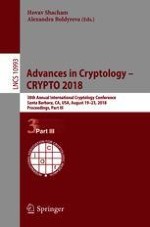2018 | OriginalPaper | Chapter
Cryptanalyses of Branching Program Obfuscations over GGH13 Multilinear Map from the NTRU Problem
Authors : Jung Hee Cheon, Minki Hhan, Jiseung Kim, Changmin Lee
Published in: Advances in Cryptology – CRYPTO 2018
Publisher: Springer International Publishing
Activate our intelligent search to find suitable subject content or patents.
Select sections of text to find matching patents with Artificial Intelligence. powered by
Select sections of text to find additional relevant content using AI-assisted search. powered by
